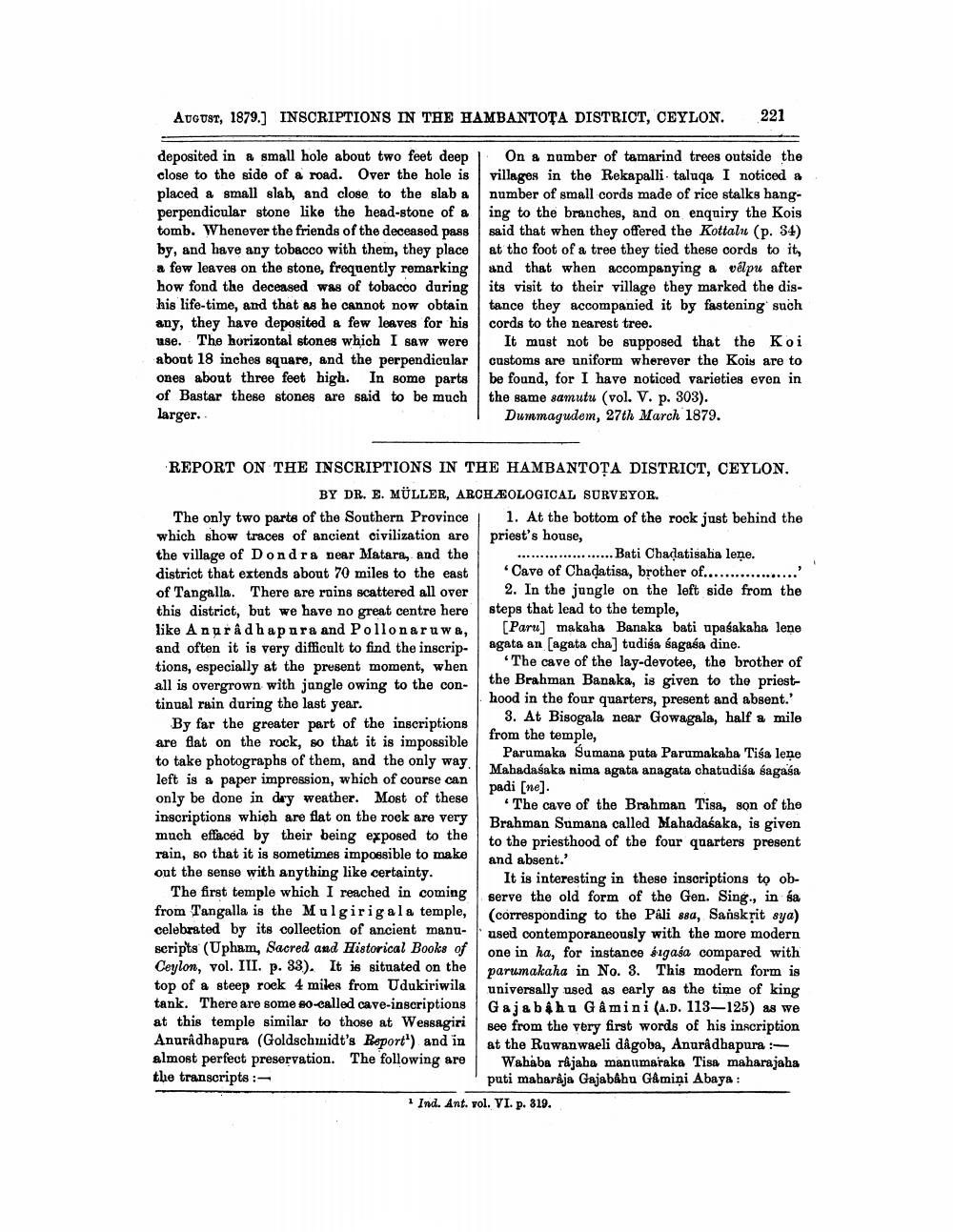________________
August, 1879.] INSCRIPTIONS IN THE HAMBANTOTA DISTRICT, CEYLON
221
deposited in a small hole about two feet deep close to the side of a road. Over the hole is placed a small slab, and close to the slab a perpendicular stone like the head-stone of a tomb. Whenever the friends of the deceased pass by, and have any tobacco with them, they place a few leaves on the stone, frequently remarking how fond the deceased was of tobacco during his life-time, and that as he cannot now obtain any, they have deposited a few leaves for his use. The horizontal stones which I saw were about 18 inches square, and the perpendicular ones about three feet high. In some parts of Bastar these stones are said to be much larger.
On a number of tamarind trees ontside the villages in the Rekapalli. taluqa I noticed a number of small cords made of rice stalks hanging to the branches, and on enquiry the Kois said that when they offered the Kottalu (p. 54) at the foot of a tree they tied these cords to it, and that when accompanying a vélpu after its visit to their village they marked the distance they accompanied it by fastening such cords to the nearest tree.
It must not be supposed that the Koi customs are uniform wherever the Kois are to be found, for I have noticed varieties even in the same samutu (vol. V. p. 303).
Dummagudem, 27th March 1879.
REPORT ON THE INSCRIPTIONS IN THE HAMBANTOTA DISTRICT, CEYLON.
BY DR. E. MÜLLER, ARCHÆOLOGICAL SURVEYOR. The only two parts of the Southern Province 1. At the bottom of the rock just behind the which show traces of ancient civilization are priest's house, the village of Dondrs near Matara, and the ..................... Bati Chadatisaha lene. district that extends about 70 miles to the east Cave of Chadatisa, brother of................' of Tangalla. There are rains scattered all over 2. In the jungle on the left side from the this district, but we have no great centre here steps that lead to the temple, like Anuradhapura and Pollonaruwa,
[Paru] makaha Banaka bati upasakaha lene and often it is very difficult to find the inscrip
agata an [agata cha] tudisa sagasa dine. tions, especially at the present moment, when
The cave of the lay-devotee, the brother of all is overgrown with jungle owing to the con
the Brahman Banaka, is given to the priesttinual rain during the last year.
hood in the four quarters, present and absent.' By far the greater part of the inscriptions
3. At Bisogala near Gowagala, half a mile
from the temple, are flat on the rock, so that it is impossible
Parumaka Sumana puta Parumakaba Tisa leņe to take photographs of them, and the only way.
Mahadasaka nima agata anagata chatudisa sagasa left is a paper impression, which of course can
padi (ne). only be done in day weather. Most of these
The cave of the Brahman Tisa, son of the inscriptions which are flat on the rock are very
Brahman Sumana called Mahadašaka, is given much effaced by their being exposed to the
to the priesthood of the four quarters present rain, so that it is sometimes impossible to make
and absent.' out the sense with anything like certainty.
It is interesting in these inscriptions to obThe first temple which I reached in coming serve the old form of the Gen. Sing., in sa from Tangalla is the Mulgirigala temple, corresponding to the PAli 88a, Sanskrit sya) celebrated by its collection of ancient manu
used contemporaneously with the more modern seripts (Upham, Sacred and Historical Books of
one in ha, for instance sigaša compared with Ceylon, vol. III. p. 33). It is situated on the
parumakaha in No. 3. This modern form is top of a steep roek 4 miles from Udukiriwila
universally used as early as the time of king tank. There are some so-called cave-inscriptions Gajabhu Gamini (A.D. 113–125) as we at this temple similar to those at Wessagiri
see from the very first words of his inscription Anuradhapura (Goldschmidt's Report") and in at the Ruwanwaeli dågoba, Anuradhapura :almost perfect preservation. The following are Wahaba räjaha manumaraka Tisa maharajaha the transcripts :
puti maharaja Gajabâhu Gåmiņi Abaya : Ind. Ant. vol. VI. p. 319.




